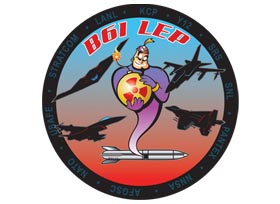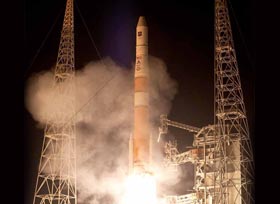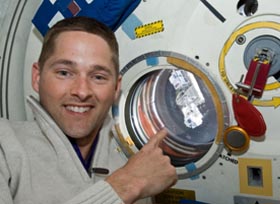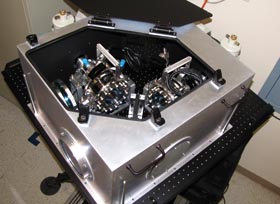Sandia's scientists and engineers have a significant impact on national security and continually deliver results, including these noteworthy successes from fiscal year 2011:

Advanced Hypersonic Weapon test flight
In the early hours of Nov. 17, 2011, Sandia conducted a highly successful first test flight of the Advanced Hypersonic Weapon (AHW) concept for the U.S. Army Space and Missile Defense Command. Designed to fly within the earth’s atmosphere at hypersonic speed and long range, the first-of-its-kind glide vehicle launched from Sandia’s Kauai Test Facility in Kauai, Hawaii, using a three-stage booster system developed at Sandia. The hypersonic glide vehicle, which was also designed and developed by Sandia, successfully flew at hypersonic speed to the planned impact location at the Reagan Test Site, U.S. Army Kwajalein Atoll. The test flight allowed researchers to collect data on hypersonic boost-glide technologies and test range performance for long-range atmospheric flight with emphasis on aerodynamics; navigation, guidance and control; and thermal protection technologies.
The Department of Defense is using AHW to develop and demonstrate technologies for Conventional Prompt Global Strike (CPGS), which would allow the military to deliver a conventional weapon strike anywhere in the world within one hour.
Additional areas of accomplishment include:
-
Nuclear Weapons Engineering

B61 Life Extension Program: Operating on a compressed schedule and with ongoing changes in scope, the B61 Life Extension Program team completed Phase 6.2 and 6.2A weapon development activities. Major milestones in these activities included the Phase 6.2 design review, Integrated Phase Gates B and C, the Weapons Design and Cost Report, and Phase 6.2/6.2A report. These activities were delivered on schedule to NNSA and culminated in the request for Phase 6.3 authorization to the Nuclear Weapons Council in November.

Tonopah Test Range: The Nuclear Enterprise Assurance (NEA) team established the organizational and procedural basis at Sandia and within the Nuclear Security Enterprise for identifying and mitigating cyber and supply chain vulnerabilities. The effort established the core integration approach as well as processes and tools from the four major Sandia “pillars” including vulnerability analysis, threat analysis, mitigation options development, and trusted implementations. The NEA team also established a key partnership with the Kansas City Plant, creating a working group that has mapped out the combined NEA approach between the two organizations. This partnership has provided the basis upon which NNSA is building its NEA approach, with Sandia as a key leader in the enterprise-wide effort. Analyses have been completed on select weapon components, as well as critical Sandia infrastructure in joint efforts with their parent organizations.

Direct Optical Initiation Firing Set: An electrical prototype of the Direct Optical Initiation Firing Set has been successfully demonstrated to be at a Technology Readiness Level 4: prototype validated in a laboratory environment. Key interface performance requirements were met using a commercially manufactured laser whose design was realized through investments in multiple Sandia science and technology areas. The laser and beam conditioning optics represent a major step toward simplifying this technology into a manufacturable firing set for a nuclear weapon application.

Arming, Fuzing, & Firing: Sandia began the Phase 6.2/6.2A Conceptual Design and Cost study to develop a replacement arming, fuzing, and firing (AF&F) system for the Navy Mk5/W88 reentry system. The project, known as the W88 Alt. 370, has the key mission to develop an AF&F system suitable for use in the Navy Mk5/W88-0 that can also be adapted for use in the Air Force Mk21/W87 and Mk12A/W78-1 life extension programs. Key FY11 Accomplishments include the completion of major design trade studies, establishment of baseline requirements, and development of an early conceptual design.

Advanced Arming & Fuzing Concepts: Members of Weapons Controller Dept. 5351 successfully completed the development of advanced arming and fuzing concepts in collaboration with the Atomic Weapons Establishment of the United Kingdom. This team designed, developed, and produced a subsystem prototype that demonstrated key technologies needed for next-generation reentry system controllers. This project helped reduce the risk, time, and cost for the upcoming refurbishments. The new architecture allows a similar controller to be applied to both Navy and Air Force reentry systems.

Integrated Lifecycle Security: Sandia’s Integrated Lifecycle Security (ILS) project developed a methodology and tool set to assess the state of security across the nuclear weapon stockpile and to evaluate the effectiveness of potential security improvement proposals. ILS was recently selected by NNSA as the basis for a common enterprise-wide approach to evaluating stockpile risk. Sandia is now engaging with NNSA, Los Alamos and Lawrence Livermore national laboratories, and elements of the Department of Defense to perform a comprehensive security risk assessment, which is intended to inform national weapons policy and planning decision makers.
-
Remote Sensing

Synthetic Aperture Radar: Sandia-developed synthetic aperture radars (SAR) are fielded on unmanned aerial vehicles to locate and help defeat improvised explosive devices (IEDs). This system was unanimously recommended as a proven counter-IED system by the Department of Defense. The following quote demonstrates this system’s impact: “That thing is amazing. I wish we had it from the beginning; a lot of people would still be around right now. I have witnessed two occasions…where things could have turned out bad and you all saved the day.”

Buried Energy Harvester: Zero maintenance, out-of-sight, continuous power is required for many remote-sensing applications. To meet this need, Sandia’s Power Source Technology Group developed a buried energy harvester that converts diurnal heat flow through the upper soil layer into electricity. The device uses power management circuitry, aerogel insulation, and more than 5,000 thermoelectric elements to maximize efficiency and voltage from small temperature differences. One year of continuous field testing confirmed simulations predicting milliwatts of continuous power.

Nuclear Detonation Detection: For nearly 50 years, NNSA, its predecessors, and the U.S. Air Force have jointly developed and launched satellite sensor systems designed to detect atmospheric and space nuclear detonations (NUDETs). On July 16, 2011, the second payload of the next-generation sensor systems was launched on a Global Positioning System satellite. This new generation of sensor systems is designed to significantly enhance the nation’s ability to monitor nuclear treaty compliance over the entire planet, 24 hours a day, 365 days a year. Over the next 10 years, researchers will be launching 18 more next-gen sensors.

Infrared Photodetector Technology: Sandia has developed new infrared photodetector technology that dramatically enhances the sensitivity and resolution of mid-infrared focal-plane arrays used in tactical and strategic sensors. This achievement is based on a unique novel device architecture that suppresses inherent dark current mechanisms and was enabled by accompanying advances in devices physics and semiconductor material science. Large-format focal plane arrays were recently made at Sandia and demonstrated to various interested agencies. The research continues on developing multi-color capability and chip-scale photonic integration to enable additional functionalities.

Technical Nuclear Forensics: Several agencies are developing a Technical Nuclear Forensics capability with various measurements to determine technical information about a terrorist nuclear weapon that might be detonated in a city. Yield is an important parameter that might be determined by comparing measured and simulated signals from optical sensors. A proof-of-concept exercise was completed in which a “red” team prepared simulated signals from a detonation near Madison Square Garden and a “blue” team successfully determined the yield and location by varying inputs to Sandia simulation tools.

Tagging, Tracking, & Locating Grand Challenge: Fostering game-changing technical solutions for today’s warfighter, the Tagging, Tracking, and Locating (TTL) Grand Challenge LDRD was successfully completed with numerous technical achievements and real-world system demonstrations. Led by Center 5300 with major contributions from Center 1700 and the University of Illinois at Urbana-Champaign, the TTL Grand Challenge team authored novel radio-frequency (RF) communications algorithms, produced state-of-the-art MEMS microresonators critical for device miniaturization, developed new placement-insensitive and embedded antennas, and demonstrated both wide-area search and high-fidelity location in a single device. The TTL Grand Challenge generated significant intellectual property and contributed to a 2011 R&D 100 Award for MEMS microresonator technology. Numerous technologies developed by the TTL team have propagated into real-world solutions across a broad range of US government applications.

Orbiter Inspection System: Working with NASA, the Sandia LDRI Orbiter Inspection System (LOIS) team provided critical life safety inspections of the Space Shuttle on orbit during each flight post Columbia. This specialized capability was developed rapidly to allow NASA to return to flight in support of the International Space Station. The Sandia team was on console in Mission Control Center Houston for all 22 missions including the historic last shuttle mission. The team provided support, yielding perfect mission success. Like all successes, this required great personal sacrifice from the team.
-
Computing & Information Sciences

Virtual machine software: Sandia researchers released a virtual machine introspection software library called LibVMI. This software provides foundational capabilities that enable solutions to many important applications such as increasing the security of cloud computing environments, performing runtime debugging and analysis of malicious software, and forensic analysis of compromised computers. LibVMI works by providing an external view into the memory of software running inside virtual machines or memory snapshots. LibVMI is freely available as an open source project at http://vmitools.sandia.gov/.

Adiabatic Quantum Architectures: The Adiabatic Quantum Architectures In Ultracold Systems (AQUARIUS) Grand Challenge LDRD team successfully ran Sandia’s first quantum computation. The one-qubit machine built by the team processes a cesium atom laser cooled below 100 microkelvin. By “adiabatically” staying in its lowest-energy state, the device resists noise intrinsically. Its inaugural test-run calculation determined with high probability that 1 is greater than 0. While simple, a 50-qubit computer could outperform all the world’s supercomputers for some problems. Sandia’s unique fabrication facilities enable key AQUARIUS technologies, including nanoscale diffractive optics for atom trapping and control.
-
Military Programs

Blast-induced Traumatic Brain Injury: Members of Integrated Military Systems Center 5400 are investigating, in collaboration with the University of New Mexico Health Sciences Center, blast-induced traumatic brain injury (TBI) and its mitigation by means of protective headgear by conducting high performance computational studies. This work studies the relationship between impulsive loading and the intracranial stresses and wave energies experienced by the brain during blast exposure. Threshold values of intracranial stress and wave energy are identified that necessarily lead to TBI and are used as metrics to assess the protective merit of various helmets.

Aegis Ballistic Missile Defense: Sandia’s Integrated Military Systems Program supported the Aegis Ballistic Missile Defense program on March 9, 2011, with a successful ARAV-C++ launch from the Kauai Test Facility (KTF). During the mission, Sandia provided launch support and produced the missile’s attitude control module (ACM) containing all electrical, navigation, and communication systems along with a complex hydrazine propulsion system. On March 15, KTF provided range and field support for a successful launch-to-impact ballistic missile tracking test of the Missile Defense Agency’s Space Tracking and Surveillance System (STSS), testing whether two low Earth-orbiting satellites could track a missile through all phases of flight.
-
Microelectronics & Microsystems

Microresonator Filters: The next generation of mobile computing devices will require advanced radio frequency (RF) filter and oscillator banks covering multiple frequency bands. These microsystems will perform RF filtering and frequency synthesis functions in next-generation wireless handsets, cell phones, and other wireless devices, offering higher performance and frequency diversity in a smaller package and at a lower price than current technologies. “Our miniature acoustic resonators fill this need,” says Roy Olsson (1719), the primary investigator on the R&D 100 Award-winning project. Rockwell Collins Inc. has partnered with Sandia to achieve the next-generation of microresonator filters and frequency references.

Micromechanical Features: Sandia has demonstrated the highest frequency micromechanical filters, operating in excess of 10 GHz. The filters use Sandia's R&D100 Award-winning aluminum nitride microresonator technology to shrink the filter size to 0.5 x 1.0 x 0.2 mm3, including bond pads. This is orders of magnitude smaller than the electromagnetic filters typically used in these frequency bands. The high operating frequency, extremely small size and low insertion loss make these filters ideal for application in X-band radio frequency systems, such as radars and satellite communications.
-
Global Security

Project Neptune:The Project Neptune team completed the design, fabrication, and integration of a unique R&D sensor focused on detection of chemicals indicative of nuclear proliferation. The Neptune sensor will be able to remotely interrogate regions of interest to determine if nuclear proliferation signatures are present. A multi-center team completed the sensor on schedule and under budget. In the spring of 2012 the team will participate in proliferation-detection field tests at the Nevada National Security Site.
-
Infrastructure Protection

Cyber Security Interoperability Framework: Sandia, EnerNex, the Tennessee Valley Authority, and Schweitzer Engineering Laboratories, partnering in the Lemnos security project, successfully demonstrated a Sandia-developed architecture and prototype implementation of a cyber security interoperability framework for communications at the Electric Power Research Institute (EPRI). The DOE Office of Electricity Delivery and Energy Reliability has highly praised and presented the Lemnos Project and the resultant product capabilities as a major success in addressing some of the challenges described in the DOE Roadmap to Secure Control Systems in the Energy Sector.
-
IT, Networks, & Facilities

Enterprise Search Capability: Judy Spomer (9515) received the Lockheed Martin Nova award for leading a multidisciplinary, multiorganizational team to improve the enterprise search capability. The team applied advanced analysis algorithms developed by Sandia researchers to enhance the ranking of Sandia search results by merging search engine scores with probabilistically derived scores based on aggregate user actions. On the most common queries, the most appropriate link is now returned as the first link 80 percent of the time. The time a user spends looking for the right link has decreased by 30 percent.
